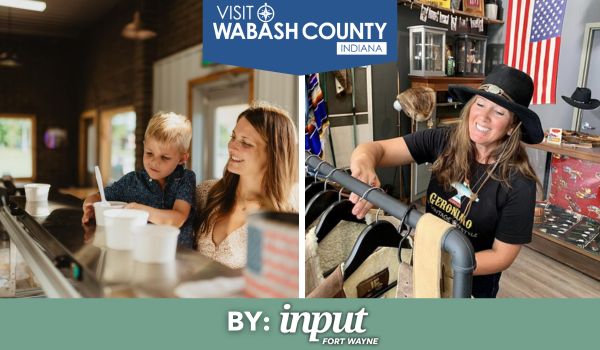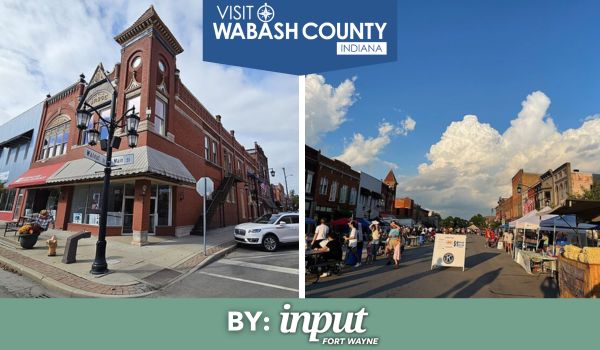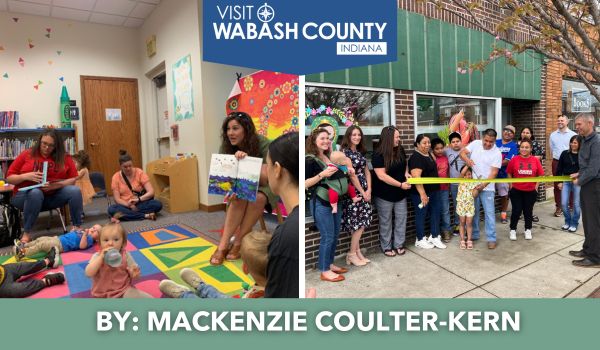Implementing Inventive Housing Solutions To Attract New Residents
Wabash is on a mission to address its declining population. Located just 45 miles southwest of Fort Wayne, the county is taking a collaborative, innovative approach. Part of that approach is finding solutions to address housing needs in their communities.
Together with The Community Foundation of Wabash County, Grow Wabash County, The Wabash County Commissioners, and the cities and towns of Wabash, North Manchester, Lagro, Roann, and LaFontaine, Imagine One 85 is a comprehensive plan to implement plans that help combat reversing population decline.

Alex Downard is the director of Imagine One 85, which aims to shift Wabash County’s four consecutive decades of population decline.
“We’re focused on making Wabash County the best place to live, raise a family, work, and play,” Downard says. “My work is on the implementation of those recommendations out of the Imagine One 85 plan.”
Imagine One 85 constructed a county-wide branding and marketing initiative with a detailed plan to help drive people to Wabash County. They partnered with Visit Wabash County and launched a LiveIN Wabash County website which shares personal stories and real-life perspectives of residents, burgeoning business owners, and growing families who live in the area.
Wabash Mayor Scott Long says the campaign aims to help turn those population numbers around.
“We’re trying to drive the population increase, and this is one facet of doing that,” Mayor Long says. “The LiveIN Wabash County campaign is one aspect of that, and there’s a focus on how to capture people from surrounding areas to come and live here.”
The website features many different tabs and pages that showcase local amenities like world-class theater and performing arts, outdoor adventures and trails, housing options across different neighborhoods and community comparisons, trusted realtors, employment opportunities, education and childcare options, retirement life, and other helpful information.
The site also includes a link to a local ambassador page, which invites potential new residents to connect with current folks who are living, working, and playing in Wabash. They can share their perspectives, give tips on local go-to spots, and might even become neighbors down the line. While marketing campaigns can be flashy and enticing, sometimes it’s best to hear it directly from the locals.

“You can reach out directly to these Wabash County residents to ask them questions about why they live here, and what it’s like to live here,” Downard says. “I’ve always said that what makes Wabash County different is that we’ve got a lot of really good people. A few of those residents and community leaders have volunteered to be ambassadors. There’s no pressure – we’re not forcing a meeting or a connection. We trust those individuals will be honest and give their fair reasons for why they chose to live here or answer any questions that potential residents or movers may have. We’re a traditional small town in terms of we will wrap around somebody when they get there and really welcome them to this community.”
There’s also a form that potential new residents can fill out, detailing information about where they currently live, what kinds of needs they’ll have regarding childcare, employment, retirement activities, housing preferences like rentals versus home ownership, and more.
“It’s a process that will follow as we look at actively taking a stance to recruiting residents here, as opposed to passively hoping that the word gets out and people move here. We’re taking an active marketing campaign and driving people to find Wabash County and visit. Christine at Visit Wabash County always says ‘it starts with a visit.’ We hope we can convert that visit to a permanent move and a resident into our community.”

Mayor Long says he has witnessed a recent shift in what attracts visitors and potential new residents to a community.
“For years, economic development used to be that you create jobs and people are attracted. Now people are attracted to communities, your quality of place, quality of life, and all the amenities you can offer are more attractive to companies that want to locate within your community. It’s kind of done a 180 on the thinking. To create quality of life, quality of place, and quality housing, that’s what’s going to attract people to the community.”
With such a strong community, it prompts one to ask why the population is declining. The answer is rather grim– it’s not due to folks moving out, but rather, aging out Downard says.
“Our death rate is almost double what our birth rate is every year,” he says. “The one thing that has shifted in the last two years is our net migration rate, the people that moved in and out of the county. We were up 185 in 2021, and in 2022, we were up an additional 190 people. We’re doing a great job of attracting people here, and when they come, they stay here.”

Part of the charm of Wabash’s community is the amount of local historic homes. With the rising cost of construction materials, many folks aren’t selling their homes– they’re staying put. This contributes to a low inventory of available houses for sale in the area.
“That’s where we have to get creative with different programs and housing initiatives,” Downard says. “We aren’t seeing as many people selling their homes today, just because of how the market has been. We’re working on a few different innovative housing types, a few different townhome projects, and a single-family shared greenspace development at the old Parkview Hospital site, called Legacy Heights Development.”

Part of these ‘creative solutions’ include a few recent small-scale developments and training to encourage more. Wabash has already broken ground on the Legacy Heights site, which will feature 44 units, the first of which will be constructed this year.
The organization also launched a groundbreaking small-scale developer training program to help empower individuals to bring their visions and dreams of a community to fruition. The program provides those new to real estate development, current and seasoned small-scale developers an area to collaborate and cultivate a successful ecosystem of development. By crafting connections between bankers, contractors, architects, and local government, participants can receive the groundwork for creating transformative projects in the community.
“We’ve created 11 training sessions geared around small-scale real estate development, everything from design to construction, picking and marketing projects, all around revitalization and development opportunities,” Downard says. “The second pillar of the program is project-based coaching. If somebody has a house they’re looking to flip, or want to purchase a downtown building, the coaches can help bring that vision to fruition. The third piece is for small-scale developers that don’t have the financial resources or need additional investment, so they can have the opportunity to package that project and shape out the details, to be able to pitch it to local people to invest in their project.”
Downard says the project aims to help train local people to help solve local problems in real estate, help them invest locally where they live, and create a sense of ownership. The program is in partnership with Builders Mart, which is holding the billing cost of materials for developers until completion. This helps alleviate financial burdens until the unit sells.

“It’s a unique partnership and a commitment from Builders Mart that we’re so thankful for,” Downard says. “They’ve bought into what we’re trying to do here and they’re willing to support that, and help hold some of that carrying cost that sometimes hinders development.”
Mayor Long says the solution requires a combination of many different moving parts and specific housing style preferences.
“Empty nesters are looking to downsize their family homes, and have less maintenance,” he says. “We’re looking at some potential townhomes they can move into, where they wouldn’t have a yard to mow. That in turn, opens up those family homes for the younger generation to come in and purchase at a lower price point than a brand new home. We’re looking at everything: single-family, duplexes, and multi-family, market-rate apartments also.”
Mayor Long says he hopes to market Wabash as a community that’s welcoming to new residents like young professionals, while also caring for current residents, and those starting families and ‘putting down roots’ – helping with both the attraction and retaining of the population.
Wabash is the focus of our Partner City series underwritten by Visit Wabash County. This series will capture the story of talent, creativity, investment, innovation, and emerging assets shaping the future of Wabash County, about an hour Southwest of Fort Wayne.



